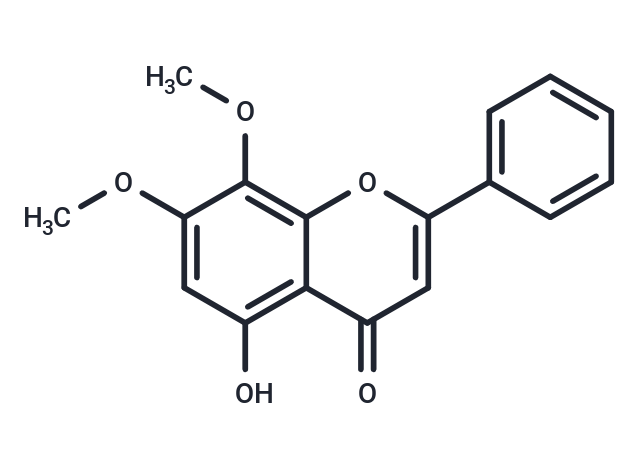Shopping Cart
- Remove All
 Your shopping cart is currently empty
Your shopping cart is currently empty

Moslosooflavone (5-hydroxy-7,8-dimethoxyflavone) has anti-hypoxia activity, it can significantly prolong the survival time of hypoxic mice. 5-hydroxy-7,8-dimethoxyflavone significantly inhibits the transcriptional activity of NF-kappaB in LPS/IFN-gamma stimulated RAW 264.7 macrophages.

| Pack Size | Price | Availability | Quantity |
|---|---|---|---|
| 1 mg | $84 | In Stock | |
| 5 mg | $196 | In Stock | |
| 10 mg | $295 | In Stock | |
| 25 mg | $497 | In Stock | |
| 50 mg | $723 | In Stock | |
| 100 mg | $987 | In Stock | |
| 500 mg | $1,980 | In Stock |
| Description | Moslosooflavone (5-hydroxy-7,8-dimethoxyflavone) has anti-hypoxia activity, it can significantly prolong the survival time of hypoxic mice. 5-hydroxy-7,8-dimethoxyflavone significantly inhibits the transcriptional activity of NF-kappaB in LPS/IFN-gamma stimulated RAW 264.7 macrophages. |
| In vitro | 5-hydroxy-7,8-dimethoxyflavone significantly decreased TNF-alpha, IL-6, macrophage inflammatory protein-2 (MIP-2), and nitric oxide (NO) secretions from LPS/IFN-gamma stimulated RAW 264.7 cells[1]. |
| In vivo | 5-hydroxy-7,8-dimethoxyflavone can significantly prolong the survival time of hypoxic mice[2]. |
| Animal Research | The chemical constituents, isolated and purified by column chromatography from Saussurea invo lucrata, were identified by several spectroscopic methods. The anti-hypoxic activities of these compounds were examined using the normobaric hypoxic model of mice[2]. |
| Alias | 5-hydroxy-7,8-dimethoxyflavone |
| Molecular Weight | 298.29 |
| Formula | C17H14O5 |
| Cas No. | 3570-62-5 |
| Smiles | COc1cc(O)c2c(oc(cc2=O)-c2ccccc2)c1OC |
| Relative Density. | 1.321g/cm3 |
| Storage | Powder: -20°C for 3 years | In solvent: -80°C for 1 year | Shipping with blue ice. | |||||||||||||||||||||||||
| Solubility Information | DMSO: 10 mg/mL (33.52 mM), Sonication is recommended. | |||||||||||||||||||||||||
Solution Preparation Table | ||||||||||||||||||||||||||
DMSO
| ||||||||||||||||||||||||||

Copyright © 2015-2025 TargetMol Chemicals Inc. All Rights Reserved.